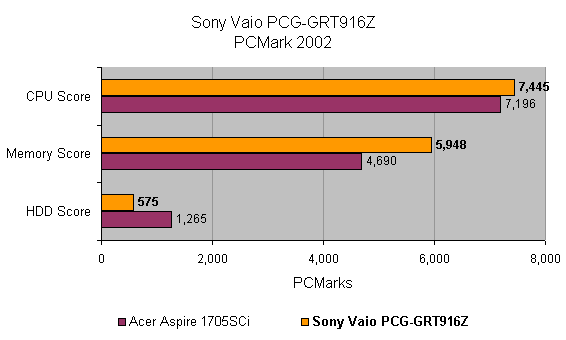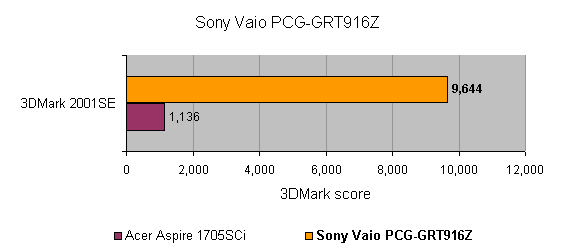Sony VAIO PCG-GRT916Z Review
Sony VAIO PCG-GRT916Z
The VAIO PCG-GRT916Z is a truly impressive desktop replacement notebook. It's powerful, well featured and has the best screen we've ever seen.

Verdict
Key Specifications
- Review Price: £1737.00
The last Sony desktop replacement notebook I looked at, the VAIO PCG-FR315S, walked away with a Recommended award by combining solid performance with a truly superb screen. Now I have the new VAIO PCG-GRT916Z sitting on my desk and once again it looks like Sony has produced a pretty compelling argument for an alternative to desktop PC computing.
The GRT916Z makes no pretence about itself; it’s a big notebook in every sense of the word. With dimensions of 375 x 47.4 x 300.3mm (WxHxD) and a weight of 4.1kg this isn’t the type of notebook that you’d want to be lugging around with you all day, but then that’s not where it’s targeted.
Despite its size the GRT916Z looks great finished in a dark metallic silver, with the VAIO logo embossed into the lid. But it’s when you open this notebook up and turn it on that you realise just how good it looks. Like the PCG-FR315S I reviewed before, the GRT916Z has what used to be called an Onyx Black screen. I say “used to be called” because Sony has now dropped the Onyx Black moniker and now calls this screen technology Ultra-Bright.
Whether or not you like Ultra-Bright is pretty subjective, but I’m a big fan. It’s true that an Ultra-Bright screen is slightly more reflective than a standard TFT panel, but I think that’s a small price to pay for the brightness, vivid colours and very strong blacks. The screen in the GRT916Z is nothing short of stunning. With a viewable area of 16.1in and a native resolution of 1,400 x 1,050 I could comfortably work all day using this notebook. The image produced by this screen is superb and I don’t mind saying that I’ve never seen a better display on a notebook computer. The colours are just so vibrant, that any other notebook display just looks pale and washed out by comparison. Sony isn’t unaware of how good this screen is and if you want a demonstration just leave the notebook idle for a while and wait for Sony’s screensaver to kick in. You’ll then be greeted with video footage of fish, flowers, lakes and such, all of which show off the rich and vivid colour palette of the Ultra-Bright screen.
Driving the excellent screen is an nVidia GeForce FX Go5600 graphics chipset. Although this isn’t the latest mobile chipset in the nVidia range it’s still good enough to play the odd game if you want to. The 3DMark 2001 SE score of 9644 is a vast improvement over the Sony VAIO FR315S which only scored 1637. So, Sony has obviously realised that a desktop replacement needs to be usable in every area, and that includes games.
The rest of the spec is pretty impressive, even by desktop standards. There’s a Mobile Pentium 4 running at 3.06GHz and 512MB of memory to back it up. Storage is well catered for by an 80GB hard disk. There’s also an integrated DVD writer that will burn DVD-R/RW, DVD+R/RW and CD-R/RW media, so backing up important data won’t be a problem.
If you’re going to be using a notebook as your main computer it needs to have good ergonomics. As I’ve already mentioned, the screen is first rate, so there’s nothing to worry about there, but the keyboard and touchpad are equally as important. Thankfully Sony has done a good job in these areas as well. The keyboard is a good example with large keys and a decent amount of travel. Of course I’d expect the keyboard in a notebook this large to be good, but as the Acer Aspire 1705SCi proved, that’s not always the case. The keys are a decent size and the right Shift, Return and Backspace keys are all enlarged for ease of use. The cursor keys are in the right configuration but they’re not set away from the main keyboard. The Spacebar is also a good size and the Ctrl key is positioned at the bottom left of the keyboard where it’s supposed to be. Many notebooks put the Fn key there instead which can be annoying.
The touchpad performed well and didn’t exhibit any of the ‘cursor jumping’ that often afflicts these devices. It’s set far enough away from the Spacebar to avoid any inadvertent cursor activation when typing, and even if you have very big hands it’s slightly recessed from the surface of the wrist rest. The two selector buttons below the touchpad are light to the touch and dragging and dropping is easy. Below the touchpad buttons are + and – volume buttons that make it easy to manipulate the volume of the notebook while in use.
There’s no shortage of connection options with the GRT916Z. If you need dial-up access there’s an integrated V.92/V.90 modem. There’s also a built-in 10/100Mbit/sec Ethernet adapter for connecting to your office or home network. And if you have a wireless network at your disposal, the GRT916Z supports both 802.11b and 802.11g WiFi standards. There’s a hard switch at the front of the notebook for turning on the wireless adapter, which is always nice to see.
Above the keyboard you’ll find the power button and a couple of very useful shortcut buttons. The first button will toggle between full and 50 per cent screen brightness. This is particularly useful if you happen to be using the GRT916Z on battery power or if you’re working in a dark room and the Ultra-Bright screen becomes a bit too intense for you. The other button offers a zoom function which resets the screen resolution to 1,024 x 768 and switches it back to 1,400 x 1,050 with another press. This is really useful if you find the native resolution a little small in some instances but don’t want to mess around with display settings all the time.
A quick look around the chassis reveals a good selection of ports and connectors. On the left you’ll find a FireWire port, a MemoryStick Pro slot and two PC Card slots that will accept one Type III or two Type II cards. At the rear are three USB 2.0 ports, a headphone socket, mic socket and video out port. Hiding behind two rubber flaps at the back are the modem socket and Ethernet port, while the power socket rounds things off. The right hand side is devoid of anything other than the battery.
Sony also bundles a great deal of software with the GRT916Z. For image editing you get both PictureGear Studio and Adobe Photoshop Elements. Video editing is catered for by Adobe Premiere 6.0 LE and DVD playback by WinDVD.
This is also the first VAIO notebook to ship with Sony’s SonicStage Mastering Studio. This allows you to record analogue audio sources onto the GRT916Z, edit them, add your own effects and export them either to a WAV file or burn them direct to a CD. In principle this is a great idea since a lot of people have old records and tapes that they’d like to transfer to CD, but there is one major issue. Unfortunately the GRT916Z doesn’t have a line-in port, so there’s no way of getting stereo sound onto the machine unless you pay £140 for a docking bar. I brought this point up with Sony and I was assured that future notebooks sporting this software will have a line-in. Ultimately though, you’re getting this software for nothing, and it does work very well, so it would be churlish of me to criticise Sony too much for the lack of line-in port. Ultimately, if you really want to use it you can decide if it’s worth the extra money for the docking bar which also adds optical S/PDIF, a serial port, a parallel port, stereo audio in/out, S-Video out, composite video out, and a PS/2 connector.
Performance wise this Sony is first rate. With a SYSmark 2002 score of 249, it’s only four points behind the far bigger and less comfortable Acer Aspire 1705SCi. And in almost every other benchmark the Sony streaks ahead. In both PC Mark 2002 and 2004 the Sony is way ahead of the Acer in every test bar hard disk performance, and that’s hardly surprising since the Acer uses a full size 3.5in drive. In 3DMark 2001 SE the Sony obliterates the Acer with a score of 9644 compared with 1136, proving that the inclusion of the nVidia GeForce FX Go5600 graphics chipset was a worthwhile decision.
The only area where the GRT916Z falls down is battery life. Under Mobile Mark the Sony only managed to last for 93 minutes. Although I was very disappointed with this result, a quick look at Sony’s specification sheet showed that it wasn’t trying to hide this fact. Sony states a maximum battery life of 90 minutes, so in reality I managed to better that slightly. That said, one and a half hours on battery is not very long at all, so you’ll have to be sure that you won’t need to use this machine on the move.
Ultimately, if you’re looking for a desktop replacement notebook and have no intention of using battery power for any length of time, the VAIO PCG-GRT916Z is a very tempting proposition.
”’Verdict”’
As a true desktop replacement this VAIO excels. The poor battery life is an issue, but the intended user will be transporting this machine between home and office. If you’re looking for a notebook that you can use as your sole computer in both home and office environments, you’d be hard pushed to find a better model than this.
(table:features)






How we test laptops
Unlike other sites, we test every laptop we review thoroughly over an extended period of time. We use industry standard tests to compare features properly. We’ll always tell you what we find. We never, ever, accept money to review a product.
Trusted Score
Score in detail
-
Performance 10
-
Value 8
-
Features 9

